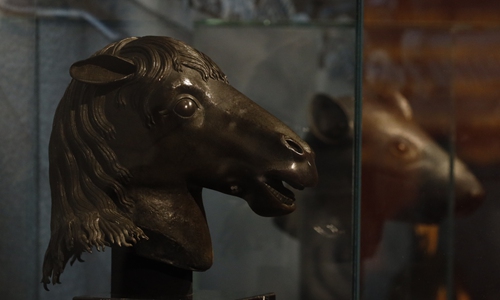Recovered Qing dynasty treasure shines at 20th anniversary of Macao’s return
By Chen Xi Source:Global Times Published: 2019/11/14 10:11:00

A picture of the horse head. Photo: Li Hao/GT
Nearly 160 years ago, British and French troops broke into Yuanmingyuan (the Old Summer Palace) and stole many valuable cultural relics, including 12 bronze zodiac head statues that were part of the palace's water clock fountain.
On Wednesday, seven of the bronze statues - the horse, ox, monkey, tiger, pig, rat and rabbit - were gathered together at the National Museum of China and displayed in the long-lost looted treasure exhibition to celebrate the 70th anniversary of the founding of the People's Republic of China (PRC).
Exquisite workmanship
The bronze horse head statue is in the fourth part of the south side of the 12 bronze statues that stood outside the Haitang Hall of the West Building of the Yuanmingyuan Garden in the Qing Dynasty (1644-1911). The 12 zodiac animal head fountain sprayed water according to the 12 hours the statues represented. At noon every day, when the bronze horse head statue representing "noon" sprayed water, the other 11 bronze statues sprayed at the same time.
Designed by the Italian artist Giuseppe Castiglione during the Emperor Qianlong period in the Qing Dynasty, the bronze statues blend Eastern and Western art styles and are an extraordinary testament to ancient Chinese art. They were based on the Western hydraulic clock and were driven by hydraulic power, which is a sophisticated design.
The horse's head was made using various techniques such as a lost wax method and a riveting process. The horse's look is vivid with its opened mouth and perfect depiction of hair, showing a very high level of craftsmanship. The material of the horse is refined red copper and it has not rusted despite being hundreds of years old.
Finally acquired
The bronze statues had a turbulent time before being returned to the motherland.
In September 2007, Macao casino tycoon Stanley Ho Hung-sun bought the horse head statue for HK$69.1 million ($8.84 million) at an auction held by Sotheby's Hong Kong, ending the drift of the statue for more than 100 years. Since then, the statue has been publicly displayed in the Hong Kong and Macao special administrative regions, playing a positive role in enhancing the understanding of compatriots in the two regions regarding the culture of the motherland and promoting the spirit of patriotism. Ho later decided to donate the statue to the National Museum of China for the 70th anniversary of the founding of the PRC and the 20th anniversary of Macao's return to the motherland. The horse head will be permanently attributed to the Yuanmingyuan management office in Beijing.
"Seven of the 12 beasts from Yuanmingyuan are now back home, but the horse is the first to return to its original territory," said Guan.
As well as the bronze horse head, the pig head was also donated by Ho after purchasing it in 2003, and he donated it to the Poly Art Museum in Beijing.
The bronze heads of the ox, monkey and tiger now also reside at the Poly Art Museum after the state-owned Chinese business group, China Poly Group Corporation, spent millions to buy them three at three different auctions.
The mouse head and rabbit head once appeared in a French museum for a short exhibition, and were later bought by the French Pinault family, owners of French conglomerate Kering, at an auction held by Christie's in France in 2009. The two were finally returned to China and were collected by the National Museum of China thanks to a donation by the Pinault family in 2013.
However, the whereabouts of five of the animal heads - the dog, rooster, dragon, sheep and snake - remain unknown, Guan Qiang, deputy head of China's relics authority, told the Global Times on Wednesday.
Big significance
The gradual return of the seven bronze heads represents the long journey home of China's looted cultural relics, and spurs memories for many Chinese people.
"Cultural relics lost overseas are an inseparable part of the Chinese cultural heritage, and patriotic compatriots from Hong Kong and Macao have played an important role in saving lost cultural relics over the past 70 years. Many of them have made tremendous contributions to retrieving lost looted cultural relics," said Liu Yuzhu, head of the Chinese National Cultural Heritage Administration, at the ceremony.
The hashtag of the horse head's return got 260 million views on China's Twitter-like Sina Weibo on Thursday, and many Chinese netizens said that Hong Kong should learn from Macao.
"Mr. Ho's high sense of patriotism to rescue the lost cultural relics and return them to the motherland is a signal that says: 'Hong Kong, stop the violence and be prosperous with your motherland,'" one Chinese netizen commented on Weibo.
"Today's donation from Macao is a slap to Hong Kong. Should Li Ka-shing do something similar?" another Chinese netizen wrote on Weibo.
"I was overwhelmed with joy while listening to the speech at the donation ceremony and saw the bronze horse-head statue. I believe the rest of the five statues will soon return to the motherland, and I am looking forward to the exhibit of the reunion of the 12 zodiac statues," said Zhang Zexin, a 68-year-old man from Shenzhen, South China's Guangdong Province.
RELATED ARTICLES:
Posted in: RELATIONSHIPS,CULTURE & LEISURE